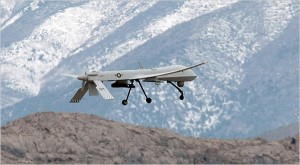
Pentagon says air force’s ‘expanding drone fleet’ is unjustified and wasteful
The Pentagon’s internal watchdog has questioned the air force’s need for 46 armed Reaper drones, and suggested the flying service is wasting $8.8bn on superfluous aircraft.
As purchases of General Atomics’s MQ-9 Reaper ballooned from 60 aircraft in 2007 to the current 401, air force officials did not justify the need for an expanding drone fleet, the Pentagon said.
During that time, costs for purchasing one of the signature counter-terrorism weapons of Barack Obama’s presidency increased by 934%, from $1.1bn to more than $11.4bn, according to a declassified September report by the Pentagon inspector general. Purchasing costs are a fraction of what the drones cost to operate and maintain over their time in service: in 2012, the Pentagon estimated the total costs for them at $76.8bn.
The Guardian obtained a copy of the inspector general’s report under the Freedom of Information Act.
Responding to heavy demand for additional aerial intelligence from troops deployed in Afghanistan, Iraq and elsewhere, the former defense secretary Leon Panetta in 2011 ordered the air force to buy sufficient drones to perform 65 combat air patrols, missions that require up to four aircraft to observe a target for nearly 24 hours.
But the air force’s air combat command “did not conduct and maintain consistent, complete and verifiable analyses for determining the necessary MQ-9 procurement quantity”, the inspector general found. Combing through insufficient or incorrect air force analyses, Pentagon investigators found that the officials “could not provide the underlying support for aircraft quantity determinations” and sidestepped a bureaucratic process for determining needed capabilities.
Military officers, however, have complained that expanding missions have overtaxed the drone fleet. In November, anonymous officials told the Daily Beast a drone shortage for surveillance and attack missions against the Islamic State (Isis) contributed to an intelligence shortfall against a premier US battlefield target.
Pentagon inspectors found that the air force’s inability to justify its continuing Reaper purchases risks wasting $2.5bn for 13 mission-ready drones; $2.1bn for 11 training drones; $958m for five test drones; $766m for four air national guard drones; and $1.7bn for nine attrition-reserve drones.
The per-cost waste of the questionable drone purchases works out to roughly $192m for each of the 46 Reapers the inspector general was unable to justify buying.
The air combat command’s director of plans said the Pentagon study significantly overstated the potential waste costs, pegging it at $593.4m for 46 Reapers instead of nearly $9bn, and underestimated the stress on the air force to provide sufficient drones for commanders.
“We are concerned that your report does not highlight these dynamic characteristics of an MQ-9 program that evolved during a period of significant conflict to meet warfighter needs at OSD [Office of the Secretary of Defense] direction,” Major General Scott J Zobrist wrote to the inspector general in August.
The inspector general replied that it included operational and support costs in its estimate, commensurate with air force acquisition data for the Reaper, to account for the discrepancy.
While not conceding that the air force does not need the 46 Reapers, Zobrist directed his staff to incorporate the inspector general’s criticisms “in our ongoing MQ-9 cost and capability ISR [intelligence, surveillance and reconnaissance] gap study”, due in March 2015. That study addresses the inspector general’s chief recommendation for the Reaper purchases.
After the inspector general released an unclassified synopsis of the report in September, the air force claimed the watchdog relied on outdated, year-old information.
“The air force is only buying 346 aircraft, 55 fewer than the 401 figure contained in the report and we’ve only received about half that number. The projected total Reaper fleet of 346 is far less the service had originally estimated prior to sequestration,” a three-star air force general told the aviation website FlightGlobal.
A different senior air force official, Major General John Winters, agreed with the inspector general that the Air Force Requirements Oversight Office “should validate necessary MQ-9 quantities and costs in an updated requirements document”.
Source: The Guardian





Leave a Reply